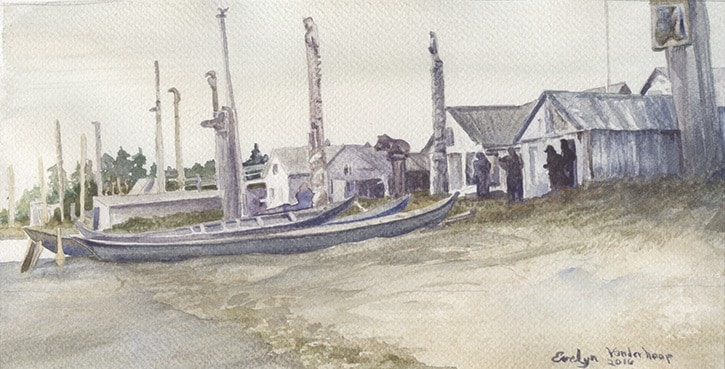Evelyn Vanderhoop was watching a memorial for the Golden Spruce when a friend gave her a nudge.
“That would make a good painting,” her friend said.
Across the Yakoun River, Vanderhoop saw the gap where the golden marvel had stood for centuries, earning the name kiidk’yaas, or ancient tree.
Raised in Ketchikan, Alaska, Vanderhoop remembers going to see the Golden Spruce with her family every time they visited Old Massett, her mother’s home village.
She heard many times about the boy who turned into kiidk’yaas—a boy who survived a punishing snowstorm, but who ignored the old man who warned him not to look back at their village as they fled up the river.
“We knew the story,” she says.
“It was a family story, not just a tree that happened to not have chlorophyll and miraculously grew bigger than all the others.”
When Vanderhoop followed her friend’s advice and painted the memorial scene, she left a reflection of kiidk’yaas on the river—and a glimpse of the boy.
That image is one of several paintings Vanderhoop will show this month at the Dixon Entrance Maritime Museum, along with a few of her textiles.
Others include a painting of the clam beach by Tow Hill, a view of Old Massett in her grandmother’s day, portraits of her grandchildren, and a portrait of the fishing boat that her husband welded hull to cabin using his father’s design.
Here On Haida Gwaii, Vanderhoop is better known as a weaver than a painter.
Twenty years ago, when she joined her mother Delores Churchill to weave her first Raven’s Tail robe in Old Massett, it was the likely first one anyone had made in the village for 200 years.
“Because my mother is an elder, people knew where we were and what we were doing,” she said.
It took two weeks just to spin the 1,000 yards of warp they needed.
Someone built them a loom. Others dropped off fish to keep them going.
“It was a really nice time,” she said.
That same year, Vanderhoop’s talent as a painter was being recognized in every corner of the United States—a US postage stamp was based on her painting of Tlingit dancer Nathan Jackson.
Vanderhoop studied painting at Western Washington University in Bellingham, and for many years she held successful exhibits, juried shows, and taught painting workshops in Martha’s Vineyard.
Because she had three young children then, Vanderhoop turned away from oils—that meant having turpentine, cadmium, and cobalt around.
“I started painting watercolours and love it,” she said.
“I’ll never go back.”
Later this month, Vanderhoop will once again paint watercolours with plenty of kids nearby—she is giving a watercolours workshop for teens at the Swan Bay ReDiscovery camp, including day trips to ancient villages in Gwaii Haanas.
“I’m not really a camper, but I love those old places,” she said, laughing.
Teaching and learning has long been part of Vanderhoop’s art. It also runs in the family.
When her mother Delores was learning to weave from her grandmother Selina Peratrovich, she would come home and find yesterday’s weaving undone again.
“If you’re going to be a weaver because you learned from me,” her grandmother said, “You’d better be good.”
Today, both of Vanderhoop’s daughters are talented weavers in their own right, and among the very few who can weave a robe or apron using Naaxiin—a complex technique developed by Tlingit and Haida weavers to make the ancient formline patterns.
Along with her watercolours, Vanderhoop will include a few of her textiles in the upcoming Masset museum show, mostly to benefit a class from the UBC Museum of Anthropology who want to see her weaving in person.
Unlike Raven’s Tail technique, which goes left to right and is limited to geometric patterns, Vanderhoop said Naaxiin allows a weaver to make turns and join areas of different colours to make the formline patterns that are the foundation for figurative Haida art.
“The formline is an ancient pattern for the northwest coast people here, and it must have been so frustrating for the weavers to be restrained to geometric patterns.”
Many years ago, she said, a woman must have had an “aha” moment when she found the way to weave a smooth formline, braiding the wool so all the joins are unseen on the front of a garment.
“Oftentimes people say, ‘How did the Haidas make these?’ because there are no mountain goats here on island,” she said.
“But mountain goat was a trade item, and Haidas were very strong traders.”
For many years, people assumed Naaxiin robes must have been made like tapestries, using a shuttle loom, until weavers took a closer look and realized all the turns were done by hand.
“It’s a weave that takes time,” said Vanderhoop, who even now takes two years or more to finish a full Naaxiin robe.
“To sustain the passion, to continue to completion—you really have to love it,” she said, laughing.
